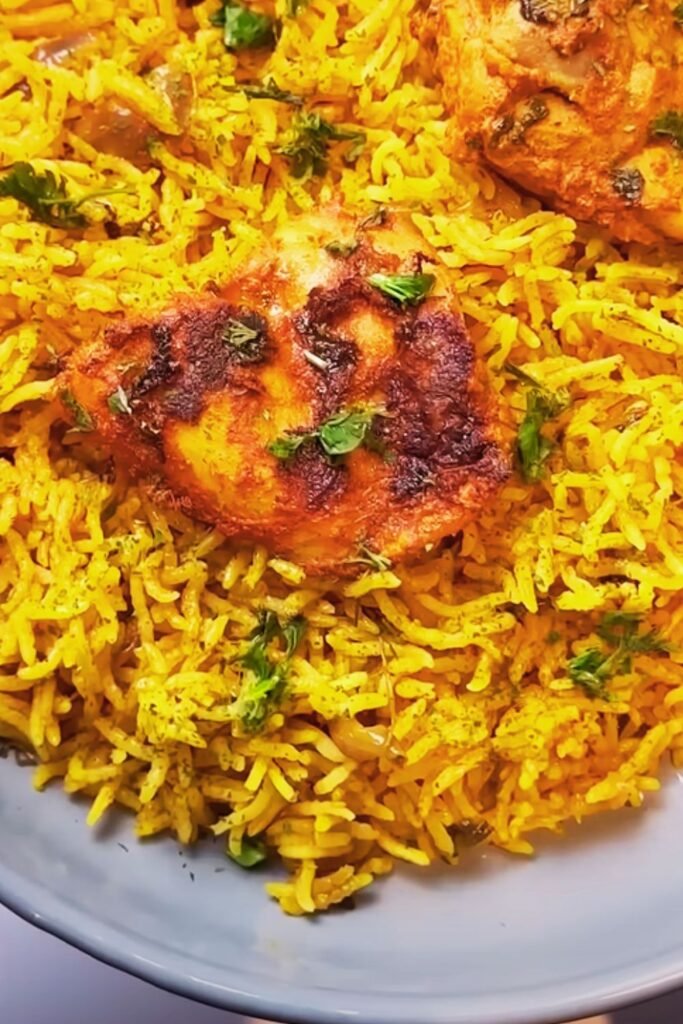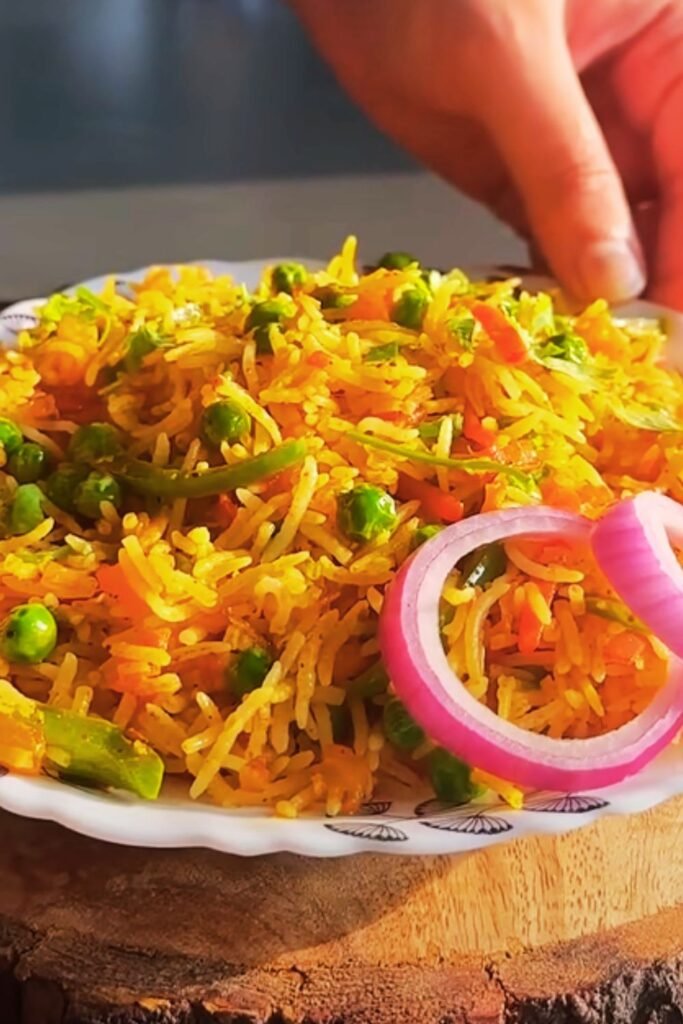When I first discovered yellow rice, it transformed my understanding of what a simple grain could become. This vibrant, aromatic dish has become one of my go-to recipes for both weeknight dinners and special occasions. The golden hue, achieved through carefully selected spices, creates not just a feast for the taste buds but also a visual masterpiece that brightens any table.
Yellow rice represents more than just a side dish – it’s a celebration of flavor, color, and cultural heritage that spans across continents. From the saffron-infused rice of Spain to the turmeric-rich variations found in Latin American and Caribbean kitchens, this dish tells stories of spice trades, family traditions, and culinary innovation.
Understanding Yellow Rice: More Than Just Color
Yellow Rice : A seasoned rice dish characterized by its golden color, typically achieved through saffron, turmeric, or annatto, combined with aromatic spices and sometimes vegetables or proteins.
Saffron : The most premium spice used in yellow rice, derived from the Crocus flower stigmas, providing both color and a distinctive floral flavor.
Turmeric : A more accessible alternative to saffron, offering earthy flavors and vibrant yellow coloring with additional health benefits.
Sofrito : A flavor base commonly used in Latin American yellow rice, consisting of sautéed onions, garlic, peppers, and herbs.
The beauty of yellow rice lies in its versatility and the way it adapts to different culinary traditions while maintaining its essential character. In my kitchen, I’ve experimented with various approaches, from the traditional Spanish paella-style preparation to the Caribbean versions that incorporate coconut milk and scotch bonnet peppers.
The Science Behind the Golden Color
Understanding how yellow rice achieves its signature appearance helps me create more consistent and vibrant results. The color comes from specific compounds in the spices we use:
Saffron contains crocin, a carotenoid that dissolves in water and alcohol, releasing both color and flavor. When I use saffron, I always steep it in warm broth or water first to maximize its potential. The investment in quality saffron pays off dramatically in both taste and appearance.
Turmeric, my more budget-friendly alternative, contains curcumin, which provides the golden color along with anti-inflammatory properties. I’ve learned that turmeric can sometimes turn rice slightly orange if overused, so I measure carefully to achieve that perfect golden tone.
Annatto seeds, popular in Latin American cooking, release a beautiful orange-red color when heated in oil. This method creates a different flavor profile – slightly nutty and peppery – that I particularly enjoy in Caribbean-inspired versions.

Essential Ingredients for Perfect Yellow Rice
Creating exceptional yellow rice requires attention to ingredient quality and proportions. Through countless attempts, I’ve developed this comprehensive ingredient guide:
| Ingredient Category | Primary Options | Secondary Options | Quantity per 2 cups rice |
|---|---|---|---|
| Rice Base | Basmati, Jasmine | Long-grain white, Bomba | 2 cups |
| Coloring Agent | Saffron threads | Turmeric powder, Annatto | 1/4 tsp saffron OR 1 tsp turmeric |
| Liquid | Chicken broth | Vegetable broth, water | 3-4 cups |
| Aromatics | Yellow onion, garlic | Shallots, green onions | 1 medium onion, 3 cloves garlic |
| Fat | Olive oil | Butter, coconut oil | 2-3 tablespoons |
| Seasonings | Salt, black pepper | Cumin, paprika | To taste |
The quality of rice makes an enormous difference in the final result. I prefer basmati for its individual grain separation and aromatic qualities, though jasmine rice creates a slightly stickier, more cohesive texture that some prefer. Long-grain rice consistently produces better results than short or medium-grain varieties for this dish.
My Step-by-Step Yellow Rice Method
After perfecting this recipe through numerous trials, I’ve streamlined the process into manageable steps that consistently deliver restaurant-quality results:
Preparation Phase
- Rinse rice until water runs clear to remove excess starch
- Steep saffron in 1/4 cup warm broth for 10 minutes
- Dice onions finely and mince garlic
- Measure all seasonings and have them ready
Cooking Process
- Heat the oil in a heavy-bottomed pot over medium heat
- Sauté the aromatics – add onions and cook until translucent, about 5 minutes
- Add garlic and cook for another minute until fragrant
- Toast the rice – add rice and stir for 2-3 minutes until lightly golden
- Add liquid and spices – pour in the saffron mixture and remaining broth
- Season generously with salt and pepper
- Bring to a boil, then reduce heat to low
- Cover and simmer for 18-20 minutes without lifting the lid
- Rest off heat for 10 minutes before fluffing with a fork
The key insight I’ve gained is that patience during the resting phase creates the perfect texture. Rushing this step results in uneven cooking and sticky rice.

Regional Variations I’ve Mastered
Exploring different cultural approaches to yellow rice has expanded my culinary repertoire significantly. Each variation offers unique flavor profiles and cooking techniques:
Spanish-Style (Arroz Amarillo)
My Spanish version emphasizes saffron and includes:
- Premium saffron threads for authentic flavor
- Spanish olive oil for richness
- Sometimes includes seafood or chicken
- Cooked in a wide, shallow pan for even heat distribution
Caribbean Yellow Rice
This tropical interpretation features:
- Coconut milk for creaminess
- Scotch bonnet peppers for heat (used carefully)
- Fresh herbs like cilantro and thyme
- Sometimes includes pigeon peas or other legumes
Latin American Arroz con Pollo Style
When I prepare this hearty version, I include:
- Sofrito as the flavor base
- Saffron or bijol for coloring
- Integrated chicken pieces
- Bell peppers and tomatoes for additional flavor and color
Nutritional Profile and Health Benefits
Understanding the nutritional aspects of yellow rice helps me make informed choices about serving sizes and accompaniments:
| Nutrient | Per 1 Cup Serving | Daily Value % |
|---|---|---|
| Calories | 205 | 10% |
| Carbohydrates | 45g | 15% |
| Protein | 4g | 8% |
| Fat | 1g | 2% |
| Fiber | 1g | 4% |
| Iron | 2mg | 11% |
| Magnesium | 25mg | 6% |
| Turmeric Benefits | Anti-inflammatory compounds | Variable |
The addition of turmeric provides curcumin, which offers anti-inflammatory properties. When I use coconut milk in Caribbean versions, the dish gains healthy medium-chain fatty acids. The herbs and spices contribute antioxidants and additional micronutrients.
Troubleshooting Common Yellow Rice Problems
Through my cooking journey, I’ve encountered and solved numerous yellow rice challenges:
Problem: Rice turns out mushy
- Solution: Use less liquid (start with 1.5:1 ratio instead of 2:1)
- Ensure proper rinsing to remove excess starch
- Avoid stirring during cooking
Problem: Uneven coloring
- Solution: Properly dissolve saffron or turmeric in liquid first
- Stir rice gently once after adding liquid
- Use consistent heat distribution
Problem: Bland flavor
- Solution: Season the cooking liquid, not just the rice
- Toast rice briefly before adding liquid
- Include aromatic vegetables as flavor base
Problem: Burnt bottom
- Solution: Use heavy-bottomed pot for even heat
- Reduce heat once boiling
- Never cook on high heat throughout

Serving Suggestions and Pairings
Yellow rice’s versatility makes it an excellent companion to numerous dishes. I’ve discovered these particularly successful combinations:
Protein Pairings
- Grilled chicken with cilantro-lime marinade
- Pan-seared fish with tropical salsa
- Braised beef with sofrito base
- Roasted pork with garlic and herbs
- Black beans and plantains for vegetarian meals
Vegetable Accompaniments
- Sautéed bell peppers and onions
- Steamed broccoli with lemon
- Roasted root vegetables
- Fresh avocado slices
- Pickled jalapeños for heat
Complete Meal Ideas
When I serve yellow rice as part of a complete meal, I consider color, texture, and flavor balance. A typical plate might include yellow rice, black beans, grilled protein, and fresh vegetables for a satisfying and nutritionally complete dinner.
Storage and Reheating Guidelines
Proper storage extends the life of yellow rice and maintains its quality:
| Storage Method | Duration | Best Practices |
|---|---|---|
| Refrigerator | 3-4 days | Store in airtight container |
| Freezer | 2-3 months | Portion in freezer bags |
| Reheating Stovetop | 5-7 minutes | Add splash of broth |
| Reheating Microwave | 2-3 minutes | Cover with damp paper towel |
I always cool rice completely before refrigerating to prevent bacterial growth. When reheating, adding a small amount of liquid helps restore the original texture.
Advanced Techniques for Exceptional Results
After mastering the basics, I’ve incorporated these advanced techniques to elevate my yellow rice:
Layering Flavors
- Create a sofrito base with multiple vegetables
- Use homemade stock instead of store-bought
- Add bay leaves during cooking (remove before serving)
- Finish with fresh herbs for brightness
Texture Optimization
- Toast rice in dry pan before adding oil for nuttier flavor
- Use combination of fats (olive oil and butter) for richness
- Add final drizzle of good olive oil before serving
Visual Appeal
- Garnish with fresh herbs and lemon wedges
- Include colorful vegetables like red bell peppers
- Serve in vibrant bowls to complement the golden color
Q&A Section
Q: Can I make yellow rice without saffron? Yes, absolutely! I frequently use turmeric as a substitute, which provides beautiful color and earthy flavor at a fraction of the cost. Use about 1 teaspoon of turmeric powder per 2 cups of rice.
Q: Why does my yellow rice sometimes turn out sticky? Sticky rice usually results from not rinsing the rice properly or using too much liquid. I always rinse rice until the water runs clear and use a 1.5:1 or 1.75:1 liquid-to-rice ratio.
Q: Can I add vegetables directly to the rice while cooking? I prefer to sauté harder vegetables like carrots and peppers separately first, then add them during the last 10 minutes of cooking. This prevents overcooking and maintains better texture.
Q: How do I know when the rice is perfectly cooked? The rice is done when all liquid is absorbed and the grains are tender but still have a slight bite. You should see small holes or craters on the surface when it’s ready.
Q: Can I make yellow rice in a rice cooker? Yes! I use the same ingredient ratios but add all ingredients to the rice cooker at once. The cooking time may vary slightly depending on your machine.
Q: What’s the best way to reheat leftover yellow rice? I prefer reheating on the stovetop with a splash of broth or water over low heat, stirring gently. This method restores moisture without making the rice mushy.
Q: Can I freeze cooked yellow rice? Definitely! I portion cooled rice into freezer bags and freeze for up to 3 months. Thaw in the refrigerator overnight before reheating.
Q: Is yellow rice gluten-free? Yes, rice is naturally gluten-free. Just ensure any broth or seasonings you use are also gluten-free if you have celiac disease or gluten sensitivity.
Yellow rice has become more than just a recipe in my kitchen – it’s a reliable foundation for countless meals and a source of comfort that never fails to satisfy. The golden grains represent the perfect balance of simplicity and sophistication, making every meal feel special while remaining approachable for everyday cooking.
Whether you’re preparing a simple weeknight dinner or entertaining guests, yellow rice provides the versatility and visual appeal that elevates any meal. I encourage you to experiment with different spice combinations and regional variations to discover your own perfect version of this timeless dish.